Filed under: Uncategorized

Welcome to Madison
6:00 a.m. for 2.5 hours on a bus. Not my idea of a good time. Several hours later we were experiencing a gorgeous green city, eating cheese curds (I liked the fried ones) and listening to the experts in Wisconsin history. Stan Schultz was a hoot and, although listening to any lecturer after is difficult, he kept us all listening as he talked on about the progressive era. I wish that I had a professor like that in my undergrad. He made history sound so practical and common sense.
I loved looking at the artifacts at the Wisconsin Historic Society Library. The information that I looked at was from the Huerfano county and Trinidad area. I was drawn to it because that is the area where I went to high school. I found a telegraph dated August 12, 1913 written from the United Mine Workers of America to Adolph Germer (a union official, 1912 candidate of the Socialist Party for the Illinois legislature and a UMWA organizer in the 1914 Colorado coal strike in Denver). In it he wrote, “I am glad to know the spirit of the men in southern Colorado is genuine and I believe that if everyone is true and if the crooks are kept off of the scene, we will win a sweeping victory in Colorado. I’m sure the “crooks” that he was referring to were the “company” bosses and 8 months later the Ludlow Massacre happened. It felt like I had discovered something that no one else had and it was probably pretty unimportant when looking at the big picture. But, I guess that must be a tiny bit like historians feel when they find some treasure from history.

Melissa, Eloyda, Crystal
Lunch was great and so was the sunshine (finally). The location chosen for dinner was amazing and even if I was still full from that big lunch it was felt good to relax and enjoy the moment with new friends.
Filed under: Uncategorized

Yeah! I can blog from the 2nd floor laundry room!
Great, even the University Center discriminates against women.
And that is probably a very appropriate way to start today’s blog reguarding Hull House and Jane Addams. Jane Addams was a remarkable women and in spite of the social work degree I hold from CSU in Fort Collins, I’m embarrassed to admit that I knew very little about her before today. In a world that was dominated by males who felt that women’s only responsibilities were cooking, cleaning and caring for the children, she and other women working with her reversed the “domestic sphere a public one. She took the role prescribed to women and used it for the public good. I stand in awe of anyone who has that kind of conviction and drive.
I know how difficult it is as a female to have a family when you spend long hours caring for other people’s need, other people’s children (like teachers do). As we saw with Lucy Parsons, her family was second to her cause. I admire Jane Addams and think that she made another very responsible choice to not have her own children when she was a champion to plenty of others.
As far as the “Lesbian debate” it really pissed me off. Why is it that anyone is wasting their time on that point when there are so many other more meaningful debates. This kind of debate is just not important when you weight it against the fact that her Hull Houe projects changed the lives of so many people. I would never bring this up to my students not matter what the age group. I just feel like it detracts from the more significant contributions that were made.
I thought I’d share these great pictures.

Happy to serve others


Filed under: Uncategorized

Frank Lloyd Wright Studio and Museum
I was pleasantly surprised at how much I enjoyed the Frank Lloyd Wright Museum and walking tour. I was also excited to see how much there was that I could share with my students (Probably not in history except for a name, but definitely in math). With the many pictures that I took I could work on symmetry, patterning, horizontal and vertical lines and repetition. I could also use these for art and give students the task of being an architect and creating their pictures of homes that they create.
At the Museum of Art and Industry there was much more than I was able to fit into the hour that was allotted us. The section that I enjoyed the most was “Yesterday’s Main Street” and the Genetics display. Although there was way too much information from our presenters on the World Fair for my second graders, I did get a lot of interesting facts that I could share with them. I also took many pictures and by Tomie DePaola where its main character visits the 1893 World’s Fair. My students never have any idea what this is and the only point of reference that they have is the state fair. I am now going to take our social studies standard of ‘then and now’ and use the World Fair as an example. For the ‘now’ I will have students create their own World Fair and decide what should be included.
Filed under: Uncategorized
This was one of the more difficult learning days for me because the DBQ is geared towards intermediate and secondary education. I did however, really like the outline for using documents to investigate history. I think that this can be done with a more simplified outline and questions.

A child's tea set sitting on a window ledge
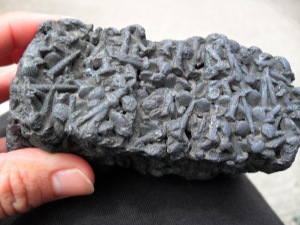
4 boxes of penny nails
In the afternoon we were able to see the destruction caused by the Chicago fire. The picture of the Palmer house before and after the fire shows the elegance and devastation that the fire caused. The other shows the magnificent job of rebuilding that was done after the fire. These pictures and the pictures that I took of the artifacts that were shared with us would be great to show kids the devastation that fire can cause.
Filed under: Uncategorized


Today I truly discovered the “Windy City”, the “Second City” and the “City of Big Shoulders” (as described by Carl Sandburg). After my terrifying first ride on the subway I walked to Chicago History Museum next to Cody, a native Chicagoan, who boasted about his beloved Chicago. He maneuvered through town with such confidence while this small town girl followed hoping not to take a wrong turn and get lost while taking pictures so that I could document my adventure and share my new transportation experiences with my students from rural Pueblo, Colorado. The beautiful buildings, the Navy Peer and Lake Michigan were definitely sights to be proud of.
We later learned from Dr. Sarah Marcus at the History Museum about the many ways that Chicago citizen tried to make their city become the best city in America before and after the Chicago fire. The events that occurred in Chicago at the turn of the century and the resources that were shared with us really deepened my understanding of the Haymarket, the Chicago fire and the riots of 1919. Later, Heidi Moisan shared with us another great site to help engage students in the history of Chicago through narratives. The follow-up activity of “historical heads” is one I could use with the book Abe Lincoln: The Boy Who Loved Books that I picked up in Springfield.
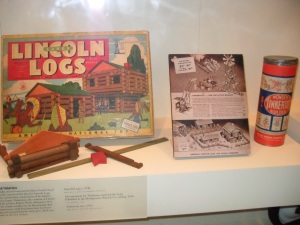
My favorite toy!

Walking through the museum I discovered more about the tragedies, crime and corruption that might make Chicago a scary place to visit. I also saw the diversity that makes the people who live here so difference, strange and unique. I experienced the richness of the cultures, fashion and talent. I felt the indulgences and greed. And finally, I revisited memories from my childhood and realized how much Chicago’s industry contributed to the world.
Filed under: Uncategorized

This morning we started out at the “replicated” old capitol building in Springfield, IL. Once told this, I lost much of my excitement. It wasn’t until I reached the governor’s office and the room next to it where Lincoln wrote that I talked with someone who worked there about some items there. (I’m not sure if everyone heard this story so, I’ll share it.)

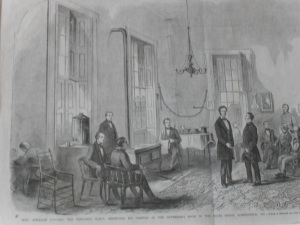
The chain that was hanging on the back wall was a replica of the one that is now hanging in the Smithsonian. It was apparently given to Lincoln by an eighty year old man who made it. The chain had one link for each state. It represented unity and how much more powerful the states were if they were linked together then separate.

There was also a very interesting 1860 original banner that hung on the wall outside of the governor’s office. The man there told some of us that it was one of the first from the Republican Party. The meercats represented Lincoln: sociable, crafty and alert.

Lincoln’s home was truly amazing. I can really imagine Lincoln actually walking into the house and placing his hat on the hat rack to the left and holding on to that handrail as he walked up the stairs to his bedroom. The authenticity of the pieces in the house made the experience much more powerful. I took many pictures that I could use to teach vocabulary to my students. One in particular that they would probably get a kick out of is “commode”.

I continued on with that teaching idea when we reached New Salem. I also took pictures that I could use as writing prompts or “commercial breaks”. I simply show the picture and ask students what they think it is and what it is used for. I would then reveal the caption including information about the item and where the picture was taken. This is a subtle way of bringing in history on a more regular basis.
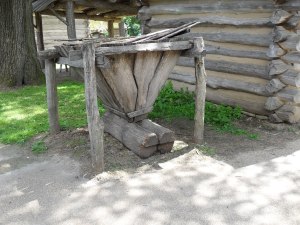

Filed under: Uncategorized

Listening to Erin Bishop speak, visiting the Abraham Lincoln Presidential Library and Museum and walking through the town where he grew up, you get a new appreciation of the impact that Lincoln had on the United States. I was very impressed with the professionalism and knowledge that Erin shared with us. There were various times in the morning where I was moved by the review of some information about Lincoln. Much of the content was not new information but it was a new way of presenting material that even the primary grades could benefit from. I could really see myself teaching much more of the history of Lincoln than I do presently. I especially liked the disc of information, the letters exchanged between Lincoln and his brother and the way that we shared the Gettysburg Address. I will use these strategies and techniques to not only teach social studies but other subjects as well. At the second grade level incorporating history to make it understandable for the students can be tricky. The images that were used (maybe not all of them) will a good way to use history to teach art.
I enjoyed the museum and especially the technology that was used to simulate images. “Lincoln’s Eyes” was especially touching for me. I think the 3-walled screens, the smells, the smoke and the sound effects really drew me in. That was one of my favorite parts of the museum. At one part in the presentation he spoke of Lincoln’s favorite boy-time reading being “Aesop’s Fables” and how he especially liked “The Lion and the Three Bulls” and how it taught him about standing together and how a house divided will not stand. The concept of teamwork is one that 2nd graders need to learn and this would be a great way to combine literacy, history and a great life lesson. I had never heard this particular story and so I looked it up on the internet and for anyone who is interested, it goes something like this:
The Lion and the Three Bulls
THREE BULLS for a long time pastured together. A Lion lay in
ambush in the hope of making them his prey, but was afraid to
attack them while they kept together. Having at last by guileful
speeches succeeded in separating them, he attacked them without
fear as they fed alone, and feasted on them one by one at his own
leisure.
Moral: Union is strength.

In the afternoon we had the opportunity to explore Springfield on our own. Among one of the many treasures we found a civil war reenactment at the old state capitol building. I like to use pictures as writing prompts for my students’ daily journaling. I thought that this would be a great way for them to see period clothing while thinking about what might be wrong. I could also change it up and ask, “What do you think about this woman’s clothing?”
Filed under: Uncategorized



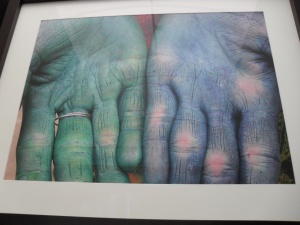
"There is no reason to look back. You're not headed that way."
“There is art everywhere” was the theme for the day for me and that is what I hope to pass on the students who enter into my classroom.
I started out my day with a visit with my nephew and his wife. They had breakfast waiting for me in their beautiful house that they are restoring on the south part of town (Bronzeville). Their house has incredible restained wooden beams are definitely art.
After we finished there we took a ride to President Obama’s house in Hyde Park and then to the 57Th Street Art Show. There I found several amazing artists there. The showed off their talent in a variety of ways. I especially liked the three paintings above. In the classroom I could use them to write narratives (especially the one of the girl on the beach by an artist named Zhiyi Li), or students could try to picture of the painted hands using their own hands. (The artist, Greg Davis, used this picture on his business card with the caption below it on the reverse side of his card. Even his business card could be considered art.) Finally, William Cowherd used his art to advertise his art. Hot only his face was art but also the words at the bottom of the page.
At the Art Institute of Chicago there were too many incredible pieces to mention. This O’Keefe painting was probably my favorite. The varying colors of yellow and the shapes might be something that kids could attempt to reproduce. They may also be encouraged to use more common natural surrounding for their own art. 
Filed under: Uncategorized
I loved this book The Jungle by Upton Sinclair. I also hated it. The fact that a person could have such a strong reaction to a book originally written in 1905 shows how powerful a piece of propaganda it truly was and continues to be. The distinction between the social classes was so evident and so upsetting. The main character, Jurgis, and his family were knocked down so many times that it made it hard to believe that conditions were that bad. The extreme conditions and the vivid descriptions brought the reader in and really made you sympathize with the characters. They were also so intense that at times I felt like they might be too exaggerated to make them real or believable. On the other hand, it really made me question how bad things were for the poor immigrants of this time. I kept asking myself how I would fare in similar situations and how did our country survive such injustices. I don’t know many people today who could persevere under the same or similar circumstances. Also, given the fact that most works of fiction have a happy ending and in this book “I will work harder” did not result in a happy ending for Jurgis and Ona made it seem more like a work of non-fiction.
The immigrants in the story came to America to find freedom as do many heroes in American history. At the primary level we teach our students that American is the land of the free and about how people came to America for a better life. The characters in this book did just that and found themselves being slaves to survival. They were really at the mercy of the owners of the stockyards, the housing, the police, etc. Everywhere they went they met up with the corruption which led to their own destruction. The heartaches and physical pains that these people suffered are unimaginable. The filthy conditions of the stockyards and the streets and the housing is so far from what we see in America today that I don’t think that most people today could take it completely seriously. Or, maybe, America is so often portrayed as the land of hopes and dreams that it is difficult to see it any other way. Jurgis and Ona came to America with such huge dreams for their future. “Jurgis had heard that America was a country where rich or poor a man was free. It was a place of which lovers and young people dreamed.” On page 27 Jurgis describes America as “as the land of high wages and high prices. The poor man was almost as poor as in any other corner of the earth; and so there vanished in a night the wonderful dreams of wealth.”
Sinclair’s descriptions of Jurgis’ feelings after losing the house that they had fought so hard to keep and later after losing his wife and two children are the parts this story that work as propaganda. Jurgis remembered himself as “being a big, strong man three years ago, and now he was sitting there shivering, broken, cowed, weeping like a hysterical child” (p. 173) And then, after living through even worse events his dreams became so far from his reach. As he thought about “the system” that he had become a part of and listened to politicians preach to the working men about making a change he “found his soul filled with hatred. What did they know about sin and suffering… these men were out of touch with the life they discussed, they were unfitted to solve its problems; they themselves were part of the problem – they were part of the order established that was crushing men down and beating them.” (p. 221) He felt that the system was just one big machine that had all its parts working together to achieve all the criminal acts of squashing the dreams of hard working people. He thought about the rich men and what they had taken from him and others like him. He remembered feeling glad that he was not the pig ready for butcher when he first came to America. Then, he sympathized with the pig thinking that he was no different. The companies “what they wanted from a hog was all the profits that could be got out of him; and that was what they wanted from the working-man, and also that was what they wanted from the public.” P. 305
The push towards socialization and unionization worked throughout the story. I felt deeply connected with the characters and what they were going through and found that I was more and more against the capitalistic companies. Sinclair embedded the need for working together against the system in all aspects of Jurgis’ journey. I was disappointed that the anticlimactic ending left me bored. I think it would have been much better if some of the characters from the story had been brought back even if they were only memories. As propaganda, I think it would have worked better to reintroduce some of the personal connections and the powerful descriptions that were used to make the reader truly feel during his story. A more powerful ending would have been to take the emotions and memories from the wedding when people were listening to the music and “Chicago and its saloons and its slums faded away – there are green meadows and sunlit rivers, mighty forests and snow-clad hills. They behold home landscapes and childhood scenes returning; old loves and friendships begin to waken, old joys and griefs to laugh and weep.” (p. 8)
